

Aishah Yunus
B.F. Skinner Operant Conditioning (Full video) Reinforcement & Punishment. Power of Reinforcements & Punishments on Teenagers. What is reinforcement? — Lake Ridge Community Support Services. Positive Reinforcement: Presenting something positive/desirable/pleasant to the person after the behaviour is exhibited, making the behaviour more likely to happen in the future.
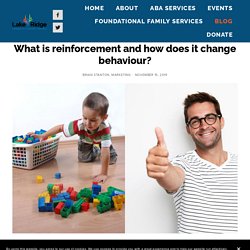
For example: Your child cleaned his/her bedroom so you praise them and reward them with a sticker. In the future, your child is now more likely to clean up his/her bedroom. Another example could include receiving praise from your family/friends for cooking a delicious meal so you want to cook more often. Negative Reinforcement: The Difference between Positive/Negative Reinforcement and Positive/Negative Punishment. February 5, 2013 7:40 pm Published by Kelley Prince M.A., BCBA In Applied Behavior Analysis, there are two types of reinforcement and punishment: positive and negative.

It can be difficult to distinguish between the four of these. Therefore, the purpose of this blog is to explain the differences in order to help parents and professionals develop appropriate interventions to improve behavior. Reinforcement. Positive vs Negative Reinforcement in ONE Minute. Positive Reinforcement. Using Positive Reinforcement to Improve Behavior.
When your child misbehaves, rewards might be the last thing on your mind.
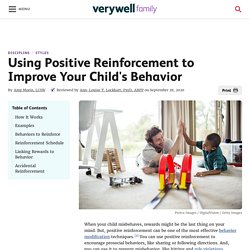
But, positive reinforcement can be one of the most effective behavior modification techniques.1 You can use positive reinforcement to encourage prosocial behaviors, like sharing or following directions. And, you can use it to prevent misbehavior, like hitting and rule violations. Positive reinforcement can also be an effective way to encourage and motivate your child to be responsible, do their chores, get along with their siblings, or complete their homework assignments without arguing.
How Positive Reinforcement Works. Positive Reinforcement - Tips for teaching and parenting. How Positive Reinforcement Improves Student Behavior. Children with learning disabilities are prone to behavior problems requiring the use of positive reinforcement.1 Having a learning disability can make a child worry that he is different from his peers, which can lead him to act out in the classroom, at home or both.
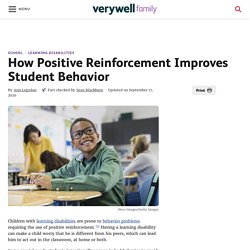
Some special needs students intentionally engage in bad behavior to avoid facing the classwork that they dread. They may lack the confidence to believe they can manage their learning disabilities. No matter the cause of worrisome behavior, positive reinforcement often helps motivate students to stop acting out in inappropriate ways. Learn more about using positive reinforcement as a behavior intervention method with this review. Negative Reinforcement (A Complete Guide)
Behavioral psychology is a branch of psychology specializing in shaping behaviors.
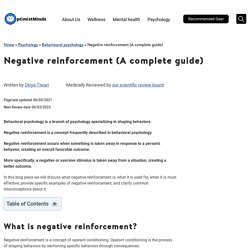
Negative reinforcement is a concept frequently described in behavioral psychology. Negative reinforcement occurs when something is taken away in response to a person’s behavior, creating an overall favorable outcome. More specifically, a negative or aversive stimulus is taken away from a situation, creating a better outcome. In this blog piece we will discuss what negative reinforcement is, what it is used for, when it is most effective, provide specific examples of negative reinforcement, and clarify common misconceptions about it.
What is negative reinforcement? Youtube. Positive Punishment. The Study of Punishment in Psychology. Punishment is a term used in operant conditioning to refer to any change that occurs after a behavior that reduces the likelihood that that behavior will occur again in the future.

While positive and negative reinforcements are used to increase behaviors, punishment is focused on reducing or eliminating unwanted behaviors. Punishment is often mistakenly confused with negative reinforcement. The difference: Reinforcement increases the chances that a behavior will occur and punishment decreases the chances that a behavior will occur. Types of Punishment Behaviorist B. What is Positive Punishment? 10 Positive Punishment Techniques & Their Effect. By: Ashley Brown Updated February 11, 2021 Medically Reviewed By: Laura Angers As a parent, it is natural to wonder about the best way to teach your child right from wrong.

Punishing them is no fun, but sometimes it has to be done if you want their behavior to change. Positive Punishment: What It Is, Benefits, and Examples. Positive punishment is a form of behavior modification.

In this case, the word “positive” doesn’t refer to something pleasant. Positive punishment is adding something to the mix that will result in an unpleasant consequence. The goal is to decrease the likelihood that the unwanted behavior will happen again in the future. Negative Punishment. How Negative Punishment Works. Negative punishment is an important concept in B.
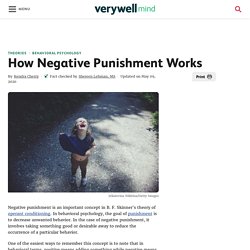
F. Skinner's theory of operant conditioning. In behavioral psychology, the goal of punishment is to decrease unwanted behavior. In the case of negative punishment, it involves taking something good or desirable away to reduce the occurrence of a particular behavior. One of the easiest ways to remember this concept is to note that in behavioral terms, positive means adding something while negative means taking something away. Negative Punishment Examples and Scenarios. Nobody ever wants their stuff taken away.

That is the main concept behind negative punishment. Using negative punishment example scenarios, gain an understanding of the concept and its effectiveness. Then, go on to explore the difference between positive and negative punishment. Exploring Negative Punishment The use of punishment is one way to deter or eliminate undesired behavior. Personal thoughts on methods of modifying behaviour. Reflection.